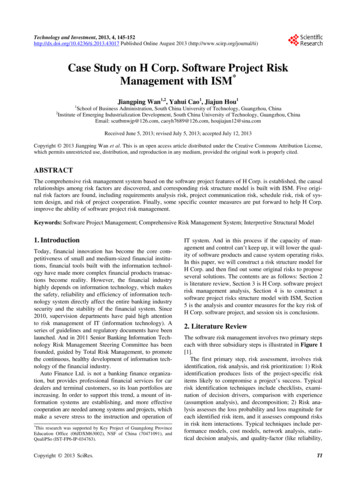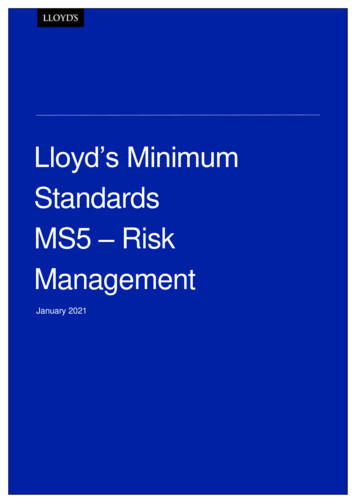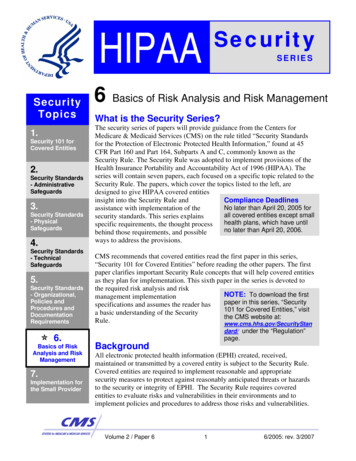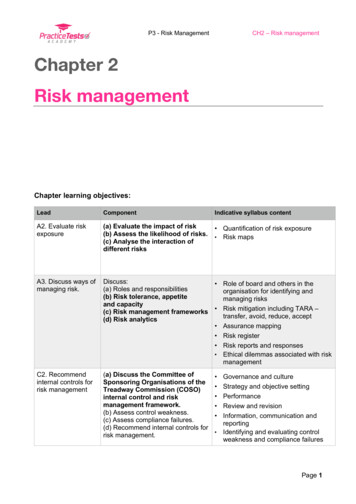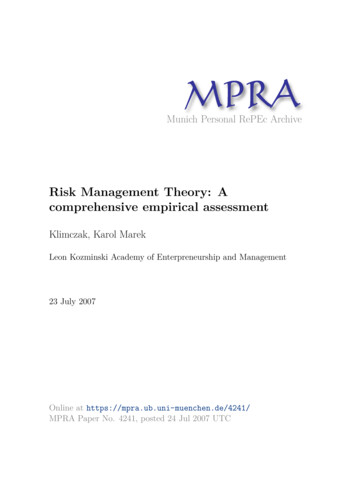
Transcription
Munich Personal RePEc ArchiveRisk Management Theory: Acomprehensive empirical assessmentKlimczak, Karol MarekLeon Kozminski Academy of Enterpreneurship and Management23 July 2007Online at https://mpra.ub.uni-muenchen.de/4241/MPRA Paper No. 4241, posted 24 Jul 2007 UTC
Risk Management TheoryRunning head: RISK MANAGEMENT THEORYRisk Management Theory: A comprehensive empirical assessmentWorking PaperKarol Marek KlimczakLeon Kozminski Academy of Entrepreneurship and Management in Warsaw, PolandKarol Marek Klimczak, Ph.D.kmklim@kozminski.edu.plPhone: (48 22) 519-21-69, (48 22) 519-21-93Fax: (48 22) 519-23-09Leon Kozminski Academy of Entrepreneurship and Managementul. Jagiellonska 57/5903-301 WarsawPoland1
Risk Management Theory2AbstractThe aim of this paper is to develop a methodology for thorough empirical testing of majorcontemporary corporate risk management theories: financial theory, agency theory,stakeholder theory and new institutional economics. Unlike in previous research, the tests areorganised around theories, rather than individual hypotheses. I used a number of tests forrobustness and subjected hypotheses to repeated testing, cross-verifying results. Evidence oftests conducted on a sample of 150 companies listed at the Warsaw Stock Exchange inPoland, covering years from 2001 to 2005, clearly point to low empirical verification of alltheories considered. However, I find evidence for some theoretical determinants: currencyexposure, market-to-book value, IT and service sectors and size. In conclusion I suggestimplications for future empirical and conceptual research.Keywords: corporate risk management, hedging, derivatives, CART
Risk Management Theory3Risk Management Theory: A comprehensive empirical assessmentWorking PaperThere have been many empirical studies aiming at finding support for the varioustheories of corporate financial risk management. However, subsequent research papers failedto determine which theories are supported by the data and which are not. In consequence boththeoretical research efforts and the design of applied methods for corporate risk managementare stalled by the inability to decide which theoretical approach to follow. After a spate ofnew research in this field in the late 90's there have been few studies that added to ourunderstanding of corporate hedging behaviour. Incidentally, most valuable pieces of researchin recent years concentrated on methodological issues: the endogeneity problem (Jin andJorion, 2006), inclusion of non-derivative hedging (Davies et al., 2006; Judge, 2006), andassumptions about the purpose of derivative use (Faulkender, 2005). In this paper I follow themethodological strain of research and propose verification of risk management theory whichis focused not on individual hypotheses but on theories. I also attempt to provide strongevidence as to the verification status of these theories by using a number of methods andsubjecting hypotheses to repeated testing.This paper aims to design and conduct an exhaustive empirical investigation into allmajor corporate risk management theories, which would provide strong statement of theirverification status. The theories considered include risk management models developedwithin the body of the following theories of the firm: financial theory, agency theory,stakeholder theory and new institutional economics. Consequently, while most researchpapers present the hypotheses in sections concentrated around particular determinants of riskmanagement, I discuss them in the order of theories from which they originated.
Risk Management Theory4The inclusion of new institutional economics and stakeholder theory, none of whichhas been tested in the context of risk management, is the first attempt to introduce thesetheories to empirical research in the field. Both theories are relatively new and immature.However, since they offer a new perspective on the problem of hedging, it is worthwhile toconsider them.Another contribution of this paper is a cohesive testing methodology. First of all, Idesigned a set of hypotheses basing on previous research. Secondly, despite using a newapproach to empirical verification, I strived to maintain comparability with previous studiesin terms of hypotheses and statistical methods. Thirdly, I tested hypotheses using a widerange of statistical methods, with repeated testing of the same hypothesis, which provideddouble verification of results. These issues are discussed in the section on methodologybelow.The choice of data also provides a new insight into risk management practices ofcompanies. The dataset for this study comprises annual report data for 150 Polish listedcompanies, in the period of 2001-2005. Few studies of economic theories are carried outusing emerging market data. In the period examined Polish companies had ready access toderivatives and were subject to International Accounting Standard 32 and 39 regulation.However only 30% used hedging, far fewer than in developed European or overseas markets.It is therefore interesting to investigate this new market and check if research results matchthose from different markets.Theories and previous researchFinancial economics approachFinancial economics approach to corporate risk management has so far been the mostprolific in terms of both theoretical model extensions and empirical research. This approachbuilds upon classic Modigliani-Miller paradigm (Miller and Modigliani, 1958) which states
Risk Management Theory5conditions for irrelevance of financial structure for corporate value. This paradigm was laterextended to the field of risk management. This approach stipulates also that hedging leads tolower volatility of cash flow and therefore lower volatility of firm value. Rationales forcorporate risk management were deduced from the irrelevance conditions and included:higher debt capacity (Miller and Modigliani, 1963), progressive tax rates, lower expectedcosts of bankruptcy (Smith and Stulz, 1985), securing internal financing (Froot et al., 1993),information asymmetries (Geczy et al., 1997) and comparative advantage in information(Stulz, 1996). The ultimate result of hedging, if it indeed is beneficial to the firm, should behigher value – a hedging premium.Evidence to support the predictions of financial economics theory approach to riskmanagement is poor. Although risk management does lead to lower variability of corporatevalue (e.g. Jin and Jorion, 2006), which is the main prerequisite for all other effects, thereseems to be little proof of this being linked with benefits specified by the theory. One of themost widely cited papers by Tufano (1996) finds no evidence to support financial hypotheses,and concentrates on the influence of managerial preferences instead. On the other hand, thehigher debt capacity hypothesis seems to be verified positively, as shown by Faff and Nguyen(2002), Graham and Rogers (2002) and Guay (1999). Internal financing hypothesis waspositively verified by Guay (1999) and Geczy et al. (1997), while it was rejected by Faff andGuyen (2002) and Mian (1996). Judge (2006) found evidence in support of financial distresshypothesis. Tax hypothesis was verified positively by Nance, Smith and Smithson (1993),while other studies verified it negatively (Mian, 1996 ; Graham and Rogers, 2002). Morerecently Jin and Jorion (2006) provide strong evidence of lack of value relevance of hedging,although some previous studies have identified a hedging premium (Allayannis and Weston,2001, Carter et al., 2006).
Risk Management Theory6The hypotheses tested in this study include all of the above rationales, except forinformation asymmetries and comparative information advantage. The first two hypothesistest the underlying assumption, that hedging leads to lower volatility of company value.Hypothesis 1a: There is a negative relationship between hedging and stock price volatility.Hypothesis 1b: There is a negative relationship between hedging a particular risk and stockprice exposure to that risk factor.The next hypothesis tests for a hedging premium by looking at companies that starthedging, rather than a cross-section of hedgers vs. non-hedgers, following the approach ofGuay (1999).Hypothesis 1c: Firms that begin hedging experience a rise in market value of equity.According to debt capacity and tax incentive rationales, firms should be interested inraising their gearing ratios, using the tax shield to the full extent, and lowering their taxcharges. Hedging facilitates this by lowering risk of default and allowing higher debtcapacity. Lower volatility of earnings may also result in lower average tax charges if the taxcurve is concave, however in Poland corporate income tax is flat-rate so this effect is notimportant.Hypothesis 1d: There is a positive relationship between hedging and debt/equity ratio.Hypothesis 1e: Firms that begin hedging, raise their debt equity ratio subsequently.Hypothesis 1f: Firms with low times interest earned ratio (EBIT/interest paid), but aboveone, hedge more often than either firms with high ratio or lower than one.Hypothesis 1g: Firms that hedge are able to pay their interest charges (times interest earnedratio 1).Hypothesis 2h: There is a negative relationship between hedging and income tax paid(relative to sales).Hypothesis 2i: Average tax charge falls after firms start to hedge.
Risk Management Theory7The final hypothesis of financial economics is linked to securing internal financing forimportant strategic projects and lowering costs of financial distress. These incentives shouldbe more important to companies with high development expenditure or other growth options.Hypothesis 2j: There is a positive relationship between hedging and growth options,represented by high R&D expenditure or high market-to-book value ratio.Agency theoryAgency theory extends the analysis of the firm to include separation of ownership andcontrol, and managerial motivation. In the field of corporate risk management agency issueshave been shown to influence managerial attitudes toward risk taking and hedging (Smith andStulz, 1985). Theory also explains a possible mismatch of interest between shareholders,management and debt holders due to asymmetries in earning distribution, which can result inthe firm taking too much risk or not engaging in positive net value projects (Mayers andSmith, 1987). Consequently, agency theory implies that defined hedging policies can haveimportant influence on firm value (Fite and Pfleiderer, 1995). The latter hypotheses areassociated with financing structure, and give predictions similar to financial theory.Managerial motivation factors in implementation of corporate risk management havebeen empirically investigated in a few studies with a negative effect (Faff and Nguyen, 2002;MacCrimmon and Wehrung, 1990; Geczy et al., 1997). Notably, positive evidence was foundhowever by Tufano (1996) in his analysis of the gold mining industry in the US. Financialpolicy hypotheses were tested in studies of the financial theory, since both theories givesimilar predictions in this respect. All in all, the bulk of empirical evidence seems to beagainst agency theory hypotheses however.Agency theory provides strong support for hedging as a response to mismatchbetween menagerial incentives and shareholder interests. The following hypotheses aredesigned to test the basic implications of this theory. The first hypothesis tests if firms hedge
Risk Management Theory8in order to decrease risk to block shareholders. The next three hypotheses address thequestion of hedging as a tool to safeguard debtholder interest and thus increase debt capacity.Unfortunately, due to data limitations I was unable to test managerial option and stockholding hypotheses.Hypothesis 2a: There is a positive relationship between hedging and individual blockownership.Hypothesis 2b: Hedging is used most often by companies with high debt/equity ratios.Hypothesis 2c: Firms start hedging more often if they have low equity/assets ratios and wishto issue debt or take out a bank loan.Hypothesis 2d: Firms start hedging more often if they have high debt/equity ratios and wishto issue debt or take out a bank loan.New Institutional EconomicsA different perspective on risk management is offered by new institutional economics.The focus is shifted here to governance processes and socio-economic institutions that guidethese processes, as explained by Williamson (1998). Although no empirical studies of newinstitutional economics approach to risk management have been carried out so far, the theoryoffers an alternative explanation of corporate behavior. Namely, it predicts that riskmanagement practices may be determined by institutions or accepted practice within a marketor industry. Moreover, the theory links security with specific assets purchase (Williamson,1987), which implies that risk management can be important in contracts which bind twosides without allowing diversification, such as large financing contract or close cooperationwithin a supply chain.If institutional factors do play an important role in hedging, this should be observablein the data. First of all, there may be a difference between sectors. Secondly, hedging may bemore popular in certain periods – in Poland one might venture a guess, that hedging should
Risk Management Theory9become more popular with years. A more concrete implication of this theory, is thatshareholders may be interested in attracting block ownership by reducing company risk. HereNIE is similar in its predictions to agency theory. However this theory also suggest that firmpractices may be influenced by the ownership structure in general. These implications aretested with the following hypotheses.Hypothesis 3a. There are differences in popularity of hedging between industries.Hypothesis 3b: The frequency of hedging changes with time.Hypothesis 3c: Hedging is positively related to individual block onwership.Hypothesis 3d: Hedging behaviour is influenced by the ownership structure: the government,institutional investors, foreign investors.Stakeholder theoryStakeholder theory, developed originally by Freeman (1984) as a managerialinstrument, has since evolved into a theory of the firm with high explanatory potential.Stakeholder theory focuses explicitly on an equilibrium of stakeholder interests as the maindeterminant of corporate policy. The most promising contribution to risk management is theextension of implicit contracts theory from employment to other contracts, including salesand financing (Cornell and Shapiro, 1987). In certain industries, particularly high-tech andservices, consumer trust in the company being able to continue offering its services in thefuture can substantially contribute to company value. However, the value of these implicitclaims is highly sensitive to expected costs of financial distress and bankruptcy. Sincecorporate risk management practices lead to a decrease in these expected costs, companyvalue rises (Klimczak, 2005). Therefore stakeholder theory provides a new insight intopossible rationale for risk management. However, it has not yet been tested directly.Investigations of financial distress hypothesis (Smith and Stulz, 1995) provide only indirectevidence (e.g. Judge, 2006).
Risk Management Theory10I have designed the following hypotheses to test for the usefulness of this theory inrisk management research. The first hypothesis addresses the importance of customer trustand resulting potentially high costs of financial distress in IT and service sectors. The secondhypothesis also looks at financial distress costs, but in a general manner – companies withhigh intangible or human assets, and growth options are more sensitive to continuityproblems. This is essentially the same as hypothesis 1j of financial economics. And finally,smaller firms are more prone to financial problems, which should increase their interest inrisk management practices. The last hypothesis is however in clear contrast to all previousempirical evidence.Hypothesis 4a: Hedging is more popular among firms form IT and service sectors.Hypothesis 4b: Companies with high market-to-book value hedge more.Hypothesis 4c: Hedging is more common among smaller firms.MethodologySince evidence in support of various risk management theories remains mixed I foundthere is a need to design a study, which will bring these theories together and test them on asingle sample using robust methodology. This approach allows comparison of theories andtheir assumptions and can provide better indication of possible ways to develop newtheoretical models. The sections below explains in detail the study design issues.DataAnalysis was conducted on a panel of Polish non-financial companies, listed at theWarsaw Stock Exchange. The panel included data of some 150 companies (numbers forparticular years varied slightly) for the period from 2001 to 2005. The last two years of theseries were used for verification of results and data for this period was gathered from 30companies selected randomly.
Risk Management Theory11The choice of Polish listed companies for theory verification requires a comment,since there may be concerns about possible idiosyncratic factors influencing risk managementin Poland. All companies included in the study were based in Poland, their ownershipstructure notwithstanding. My position is that verifying risk management theory on data froma country which is still developing can yield results as reliable as studies based on richestcountry data. Firstly, Polish companies have for the past 17 years been rapidly learning newbusiness models and techniques, including financial management. Since I have based mystudy on the assumption of rationality I am of the opinion that Polish companies based theirdecision to implement risk management on an educated judgement of pros and cons.Secondly, due to ongoing economic transition there are fewer historical and institutionaldeterminants of the current state of risk management in Poland than there might be in theUSA, UK, or Germany. Thirdly, sufficient financial market infrastructure does exist inPoland for companies to engage in risk management. Consequently, Polish companies canimplement financial risk management processes provided they find them useful.The sample was further limited to include only non-financial corporations, that iscompanies from sectors other than financial services. This approach, adopted by Nance et al.(1993), Faff and Nguyen (2002) and Berkman and Bradbury (1996) is based on the premisethat banks, insurance companies and other financial sector enterprises purchase and issuederivative instruments not only for hedging but also for trading purposes. Since both in theseand in my study derivative instruments use is a proxy for hedging such companies had to beexcluded from the sample.When it comes to data collection two alternative approaches to risk managementresearch are present in the literature: use of annual report data and questionnaires. In thisstudy I selected the former option. Although it limits the selection of variables to the contentsof official filings, data gathered using this approach are more reliable as they have been
Risk Management Theory12prepared using transparent rules specified by regulation. In the case of Poland a new lawbased on IAS 39 was introduced in 2001, which regulated the disclosure of financialinstruments, including hedging. Hence, the beginning of the series was set for the first reportsprepared according to that regulation.After reviewing variable distribution in the sample two largest companies wereexcluded as outliers. These were Telekomunikacja Polska S.A., the largest telecom provider,and PKN Orlen S.A., the largest oil refinement and distribution company. Both companieswhere incomparably larger than other companies in the sample and could not be analysedtogether with the rest of the market. Although both of them used hedging extensively, theywould have to be analysed in a sample of large European companies, rather than Polish ones.VariablesChoice of dependant variable for risk managements studies poses an importantmethodological problem: in this study I used a binary hedging proxy. I inspected manuallyannual reports of sample companies to determine whether a company used derivativeinstruments. If a company did disclose derivatives and did not state that they were used forspeculation, I classified it as a hedger. This construction of the hedging variable is of coursesubject to justified criticism. Jin and Jorion (2006) suggest using delta measures, whileFaulkender (2005) stresses the importance of first determining what derivatives are used for.Other authors point to the significance of non-derivative hedging (Judge 2006). Neverthelessthe binary proxy method has appeared most often in risk management research for practicalreasons. I decided to use this approach firstly to maintain comparability with previousresearch, and secondly, because it was impossible to determine objectively, basing on annualreports, what was the purpose of derivative use, as Polish companies refrain from using hedgeaccounting due to cumbersome regulatory requirements.
Risk Management Theory13A detailed description of variables is show in Table 1. Exposure indicators werecalculated for EUR/PLN, USD/PLN exchange rates and for WIBOR, EUR LIBOR, and USDLIBOR as betas in a CAPM style rates of return regression, following common practice in thefield (e.g. Choi and Prasad, 1995; Bradley and Moles, 2001; Chen and So, 2002; Crabb,2002). They were later changed to absolute values, as I was interested in the extent, not thedirection of exposure. Sales revenue was used as a scaling variable, since all previous studiesshowed size to be a strong determinant of risk management practices. Industry coding wasdone in accordance with the general nomenclature of the Warsaw Stock Exchange.Table 1. Description of variablesSymbolNameSymbolNameCURRTotal foreign currency denominated assets andliabilitiesinvestFShare of large foreign shareholders in equity (5% and above)EQASSEquity/Total assets ratioinvestGovGovernment's share in equity if above 5%.expEIRExposure to euro Libor 3M interest rateinvestIndShare of block individual shareholders in equity (5% andabove)expEURExposure to EUR/PLN exchange rateinvestInstShare of large institutional investors in equity (5% and above)expUIRExposure to USD Libor 3M interest rateisssueECash inflow from issued equityexpUSDExposure to USD/PLN exchange rateissueDCash inflow from issued debtexpWIRExposure to PLN Wibor 3M interest rateissueLCash inflow from new loansGEARGearing - Debt/Equity ratioMTBVMarket-to-book value of equityGEAR INT Interest bearing gearing Interest bearingdebt/equity ratioMVMarket Value of EquitygoalHBinary variable set to TRUE if firm statedhedging as the goal of derivative tradingRDR&D Expenditure - Cost of finished R&D projectsHBinary hedging variable, set to TRUE if company riskComm Binary variable set to TRUE if company used commoditydisclosed derivative instrumentsderivativesINDUSTRY Coded as: construction, chemical, timberproducts, machinery, energy, trade, IT, media,metal, construction materials, manufacturing,food, telecom, servicesriskFXBinary variable set to TRUE if company used currencyderivativesINTDEBTTotal interest bearing debt as percentage of salesriskIRBinary variable set to TRUE if company used interest ratederivativesTIETimes Interest Earned ratioTAXCorporate income tax as percentage of salesSALESRevenue from sales – proxy for firm size.VOLStock price volatility – standard deviation of weekly rates ofreturnResultsThe data was analysed using a number of techniques. All of the analysis wasperformed in R statistics package. In the first step I carried out tests of means and medians, as
Risk Management Theory14is usually done in other studies of this field. The comparison was done in two ways:statically, by comparing hedgers to non-hedgers, and dynamically, by comparing companiesthat started to hedge in a given year with companies that did not hedge. I then proceeded toHotelling's tests for difference of vectors of means, ANOVA, logit regression, and CARTanalysis. The last method, CART analysis, is in essence a decision tree method for breaking asample into two categories using a series of decision nodes. It has not yet become popular infinancial research, but as I will show below it has a number of advantages.Table 2. Sample characteristics by icalclothingconstructionconstruction talotherpharmaceuticalservicestelecomtimber productstradeN200192 (80%)23 (20%)101 (88%)14 (12%)102 (89%)13 (11%)110 (96%)5 (4%)113 (98%)2 (2%)65205213913104101127614128YEAR200296 (70%)41 (30%)112 (82%)25 (18%)111 (81%)26 (19%)127 (93%)10 (7%)134 (98%)3 (2%)8521521512131041211376151402003110 (71%)45 (29%)122 (79%)33 (21%)121 (78%)34 (22%)146 (94%)9 (6%)152 (98%)3 (2%)852153151313126131148618152Univariate tests for the difference of means (table 3) indicated significant differencesbetween hedgers and non-hedgers in size: hedgers tended to be larger both in terms of salesand market value of equity. This has been shown to be true in other markets by all previousstudies and is a clear proof of barriers or strong economies of scale which must exist in
Risk Management Theory15derivative hedging. However this result contradicts hypotheses 2a, 3c and 4c, all of whichimply that smaller, more risky firms should benefit more from implementing hedging. Twoother significant differences were in tax charges and individual block ownership. However,the sign in both cases was opposite to the predictions (hypotheses 1h, 2a and 3c).Comparisons of means between new hedgers and non-hedgers showed only two significantdifferences in the year 2002 for exposure to EUR/PLN exchange rates and WIBOR interestrate. In general tests in the dynamic approach provided widely varying results, both in termsof magnitude and sign.Table 3. Test for the difference of meansDifference of meanshedgers vs. non-hedgersVariableexpEURDifference of meansnew-hedgers vs. 1800.34570.76800.9063-0.63710.93790.52570.3506GEAR .18020.80090.99470.42500.3223In bold: p-values below 0.1 and variables with significant p-values in two subsequent years.
Risk Management Theory16Tests for the difference of medians (table 4) confirmed results of the previous test:size, tax charges and individual block holding were all significant again. However there werealso other significant differences. Hedgers tended to have a higher median of foreigncurrency assets and liabilities, which would provide a clear reason for hedging. Moreover,they exhibited lower volatility of stock prices (hypothesis 1a) and higher market-to-bookvalue (1j and 4b). Lower volatility is particularly important, as it shows that all other benefitsarising form it can be attainable. Test of new hedgers vs. non-hedgers showed no significantdifferences here.Table 4. Tests for the difference of medians.Difference of Medianshedgers vs. non-hedgersVariableDifference of Mediansnew-hedgers vs. 500.68640.80590.92337012700.66730.1023GEAR 1180.82760.75450.9804362
Risk Management Theory 1 Running head: RISK MANAGEMENT THEORY Risk Management Theory: A comprehensive empirical assessment Working Paper Karol Marek Klimczak Leon Kozminski Academy of Entrepreneurship and Management in Warsaw, Poland Karol Marek Klimczak, Ph.D. kmklim@kozminski.edu.pl Phone: (48 22) 519-21-69, (48 22) 519-21-93 Fax: (48 22) 519 .



